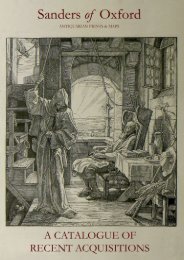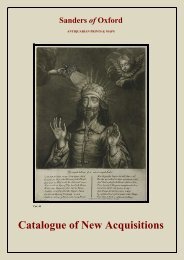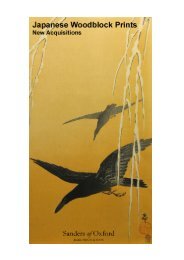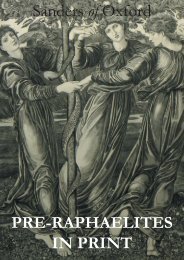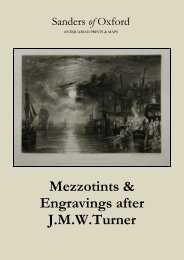You also want an ePaper? Increase the reach of your titles
YUMPU automatically turns print PDFs into web optimized ePapers that Google loves.
Publisher’s Seal: Sadaoka<br />
School: Hokusai<br />
Method: Woodblock surimono; hôsho-gami; embossed background; extensive<br />
detailing in gold [rich brass] and silver [zinc-rich brass].<br />
Format: Shikishiban<br />
Dimensions: Each impression 8 x 7 1/2 inches<br />
Code: BH163<br />
I. Green cartouche, bright red detailing on fan. Some oxidation.<br />
Price [Mounted]: £490<br />
II. Gold cartouche, faded red detailing on fan. Some soiling and movement <strong>of</strong> colour.<br />
Price [Mounted]: £450<br />
The exquisitely elegant and iki [‘cool’] bijin depicted in the upper roundel is probably a<br />
portrait <strong>of</strong> a geisha who was a particular favourite <strong>of</strong> the kyôka poet. This would seem to be<br />
confirmed by the presence <strong>of</strong> a fanciful boat-shaped form <strong>of</strong> the character nao, the first kanji<br />
<strong>of</strong> the poet’s name, Naonari Asa-no-ya, both on her fan and on the poetry slip to the right <strong>of</strong><br />
the composition. Naonari’s verse alludes to the central emblem <strong>of</strong> the auspicious kujaku or<br />
peacock, a bird <strong>of</strong>ten invoked in New Year surimono. It reads 'Tori mo kite asobu hikage no<br />
nagaki o ni kogane iro masu tama no hatsuharu' [‘The bird come and plays, and the jewelled<br />
early spring gilds the long tails <strong>of</strong> the sunbeams]. Interestingly, there was also a well-known<br />
poetic association between the peacock and the Shin Yoshiwara. At the end <strong>of</strong> the paddyfields<br />
behind the quarter, there was situated an old row <strong>of</strong> houses known as the Kujakunagaya<br />
(nagaya being a long building with several separate residences). From this rather<br />
lowly spot, the brilliant spectacle <strong>of</strong> the pleasure quarters could be seen to great advantage ~<br />
the spot thus being compared to the humble body <strong>of</strong> a peacock, with the dazzling splendour<br />
<strong>of</strong> the Yoshiwara as its magnificent tail.<br />
The two impressions <strong>of</strong> Bijin to kujaku in the exhibition demonstrate both the variations in<br />
tone, colour and decoration possible within the small print run <strong>of</strong> the surimono, and the<br />
problems <strong>of</strong> pigment experimentation in terms <strong>of</strong> long-term preservation.<br />
19. Yanagawa Shigenobu (1786-1832)<br />
Ume [Plum Blossom]<br />
Series: Sanfukyûkaigô [Series <strong>of</strong> Three Ladies]<br />
Date [Western]: ca. 1820s<br />
Date [Japanese]: Bunsei era<br />
Signature: Artist’s seal<br />
Carver: Tani Seikô [?]<br />
School: Hokusai<br />
Method: Woodblock surimono<br />
Format: Shikishiban<br />
Condition: Fading and rubbing, otherwise good<br />
Dimensions: 8 x 9 inches<br />
Code: BH162<br />
Price [Mounted]: £380<br />
Shigenobu was a pupil <strong>of</strong> Hokusai, whose daughter he married, subsequently becoming<br />
adopted into the family. After marital problems forced a separation, however, he returned to<br />
his own family in Honjo Yanagawa. From the 1810s, he designed approximately thirty<br />
surimono, mainly for the Tsuru-ren or ‘Crane Group’, and was active as an illustrator <strong>of</strong><br />
yomihon and kyôka poetry anthologies.<br />
Two kyôka verses decorate this shunkyô [Spring Season] surimono, the first, by Senyôtei<br />
Zenko, extols the beauty <strong>of</strong> the ume blossom. The bijin’s robes are decorated with various<br />
botanical motifs, including irises and wisteria.




